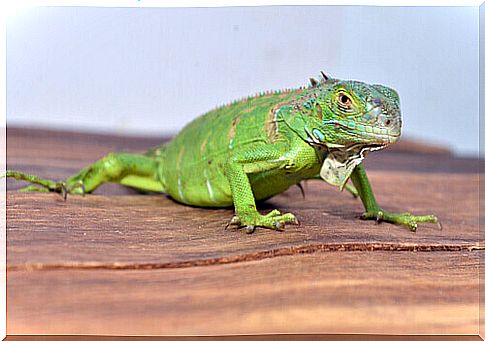Metabolic Bone Disease In Reptiles

Having an exotic pet as a pet can lead to complications, especially due to their particular nutritional needs. An error in diet is the most common cause of metabolic bone disease, which affects the bones of our reptiles.
Many of the diseases affecting these animals, just like metabolic bone disease, are easy to prevent if the needs of each species are known.
Metabolic bone disease can occur in many reptile species, such as snakes or monitor lizards. The species that most suffers from it, however, is the iguana, so that knowing the basic care to be dedicated to this animal is essential to prevent this disorder from developing.
Causes of metabolic bone disease
This disease is mainly due to a lack of calcium. This factor is closely linked to the diet, but also to vitamin D deficiencies, which favors its natural absorption.
More concretely, the disorder is due to an imbalance in the relationship between calcium and phosphorus, which are normally balanced within the body. A calcium deficiency can be due to an excess of phosphorus.

As calcium is extracted from the bones, they end up weakening and deforming in the worst case.
In addition to a lack of calcium and an excess of phosphorus in the diet, an excess of fat can also lead to reduced calcium absorption. Lack of exposure to ultraviolet rays is another cause of the disease, as it causes problems with the absorption of calcium by vitamin D.
Symptoms of metabolic bone disease
This disorder, which tends to appear in young specimens, manifests itself through inflammation of the jaw. Although this is the most obvious area of the swelling, the entire bone system is affected.
Other symptoms of the disorder include swelling of the extremities, deformities in the fingers and deviations of the spine, all of which can lead to problems with movement and even fractures.
These deformities and fractures are as evident the greater the demineralization suffered by the animal. In chronic cases where the disease has been present for longer, these become much more visible and can even lead to the use of prostheses with wheels.
In these cases it is vital to take our animal to the veterinarian, who can confirm the presence of the disease possibly by radiography. This is the best choice.
In these cases, the animal can suffer to the point of refusing to eat. This symptom is typical in chameleons, whose long tongue can be affected by the problem.
Treatment and prevention of metabolic bone disease
In milder cases, and only if you intend to prevent the disease, it will be enough to be more rigid in handling the animal.

In this sense, it will be essential to restructure his diet by incorporating natural sources of calcium. Using supplements is fine, but calcium can also be delivered naturally through plants such as dandelions.
On the other hand, the ideal diet for a turtle, an iguana or any other reptile affected by this disease can be obtained by focusing on foods in which calcium is present twice as much as phosphorus.
Furthermore, the temperature of their terrarium will have to be adapted to the species; it is good to remember that reptiles must be exposed daily to ultraviolet rays, even better if the light is natural, that of the sun to be clear.
In the best of cases, therefore, the disease can be monitored through a calcium check, always under the advice of the veterinarian. It should be emphasized that failure to treat usually leads to the death of the animal.









